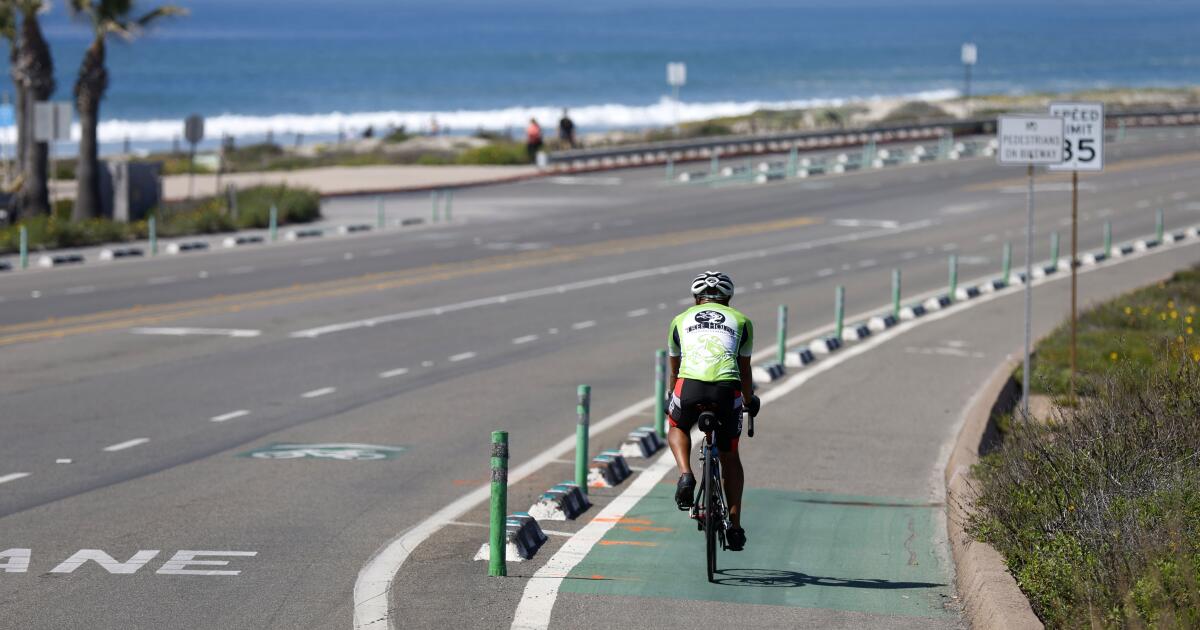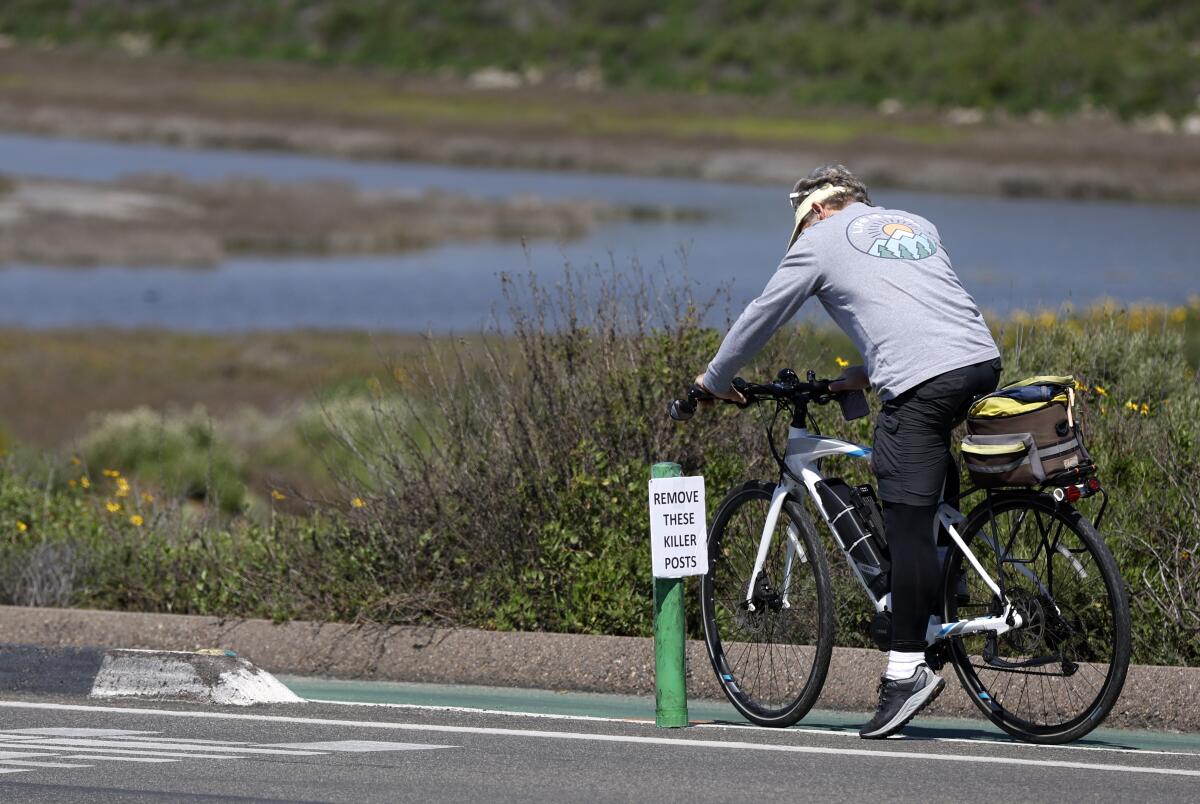
Ryan Currie, a 48-year-old Encinitas father of four — who lost his wife to cancer five years ago — was killed a week ago Sunday when he crashed his bicycle in Cardiff.
Sheriff’s investigators say Currie was not wearing a helmet as he rode north along South Coast Highway 101 shortly after midnight. He crashed near the entry point of a “protected” bike path which uses barriers — green plastic pylons and white-striped asphalt curbs topped with green reflectors — to separate riders from vehicular traffic.
Currie was found on the ground in the bike lane by a passerby. He died before he could be taken to a hospital.
The March 16 fatal crash occurred in a spot where the protected lane begins as the road slopes downward from Solana Beach. The San Elijo Lagoon is on one side of the lane, while across the street is the Cardiff State Beach parking lot.
It was dark — there are no lights along the highway. Currie’s manual Electra Townie bicycle was equipped with a light, but investigators don’t know whether it was on when he went down. There were no witnesses, and it is not known if he was impaired by drugs or alcohol. Investigators are awaiting toxicology test results as the investigation continues, said sheriff’s Sgt. Jeremy Collis.
Despite the lack of quick answers about the fatal crash, his death has prompted some in the cycling community to renew their criticism of the city’s 2019 decision to create the Class IV separated bikeway between Solana Beach and Cardiff, which they believe has created a more dangerous riding experience.
A mile-long section of the road has been the site of dozens of crashes and spills since the bikeway was put in, according to cycling enthusiast Serge Issakov. The La Jolla resident has been tracking crashes since 2020, including incidents reported via emails and texts from riders, observations of other cyclists and mishaps mentioned on social media.
According to his tally, Currie’s crash is the 32nd along the bike path since the changes were made. Many of the crashes occurred when cyclists collided with the raised asphalt barriers — which are called wheel stops and are similar to curbs at the end of parking spots.
City officials declined to comment.

A cyclist stops to remove a sign on the east side of South Coast Highway across from the Cardiff State Beach parking lot. The sign said “remove these killer posts.”
(K.C. Alfred/The San Diego Union-Tribune)
Issakov said the “protected” design is more appropriate in an urban setting. Those riders pass through intersections and are always looking ahead — which he said makes it easier to navigate the barrier-lined lanes. In contrast, he said, riders coming down the hill from Solana Beach might be surprised to find the barriers.
“A distracted rider may not notice the barrier until too late, especially at night, run into it, lose control, and crash,” Issakov said in an email. He noted there are also gaps in the barrier.
He would like to see the city get rid of the physical barriers and repaint everything “so you have buffered bike lanes and two lanes in each direction.”
Issakov and others ideally would like to see a Class IV path in the area that would be completely apart from vehicular traffic. Such a project would be expensive and require state Coastal Commission approval, but Issakov said he is “optimistic someone will find the money and have the political savvy to solve it one way or another.”
Another cyclist, Shaun Wallace, also is advocating for the barriers to be removed. Wallace, an Encinitas resident who competed in two Olympics as a cyclist for Great Britain, said he and other cycling advocates warned the city four years ago not to install them.
“I’m not against bicycle infrastructure, but I’m against bad bicycle infrastructure and this is bad infrastructure,” he said.
In supporting the project, city leaders said the bike path design provided a more secure way for less-confident cyclists to get to the beach. The lanes were installed on both sides of the highway south of Chesterfield Drive in 2020.
The lanes have been popular with parents of young cyclists — but criticized by sport cyclists who bike long distances and travel at higher speeds.
Critics said the barriers prevent them from exiting the bike lanes into vehicle lanes when they want to quickly pass a slower cyclist or avoid pedestrians or other hazards.
In response to criticism, city workers painted “sharrow” markers on the pavement in the area — making it clear cyclists are allowed to use a full vehicle lane. At some point, workers also painted white stripes on the wheel stops to make them easier to see.
The speed limit along the roadway also was lowered from 45 mph to 35 mph, riders say.
In the aftermath of Currie’s fatal crash, there was spirited debate on a Facebook page named “Encinitas: PLEASE Restore Safety in Cardiff” that has more than 1,300 followers. While some advocated for the wheel stops and bollards to be removed, others said they should stay.
Encinitas resident Marco A. Gonzalez, an attorney and cyclist, disagreed with those who wanted to remove them. “If the bollards and wheel stops are removed, I guarantee significantly fewer cyclists will have the opportunity to enjoy that stretch of road,” he wrote.
Someone on the page questioned if Gonzalez was “on someone’s payroll to troll this page,” and he replied that his opinions were “mine and mine alone” and the result of “a lifetime of cycling and 25 years of work in public policy.”
He went on to say that he and his wife knew Currie and his wife — “our daughters played soccer and surfed together.” Reached by phone on Wednesday, he expressed sympathy for Currie’s children and declined to comment beyond his social media posts.
According to a biography posted online by Spieker Senior Development Partners, Currie worked in the continuing care retirement community field, owning several projects. He was a graduate of West Point and served as a U.S. Army captain with the 101st Airborne Division, according to his bio. Messages left with the development company were not returned.
Currie and his late wife, Megan, were high school sweethearts and married in 2000, a year after she graduated from college, according to her obituary.
The obituary said she died in 2019 at the age of 41 after a long battle with cancer. The couple had four children.
Debate over the protected lane spilled into Wednesday night’s Encinitas City Council meeting, with one speaker voicing her support for the lane barriers during the public comment time period.
“We don’t know the reason for the death, and I think it’s premature to jump to conclusions,” cyclist Judy Berlfein told the council. She leads the Bike Walk Encinitas organization but said she was not speaking in an official capacity.
She told the council that she strongly disagrees with people who contend that the new barricaded bike lanes made cycling conditions less safe. She stopped riding her bike on Coast Highway years ago because she found the previous open roadway highly unsafe for slower cyclists like her.
“The corridor was formerly open to people who rode their bikes 20 mph, and closed to all the rest of us,” she said.
On Wednesday afternoon, bicyclists rode past a small sign that had been attached to a bollard in the area that read: “Remove these killer posts.” At one point, someone riding a bicycle stopped and removed the sign.
Freelance writer Barbara Henry and staff photojournalist K.C. Alfred contributed to this report.






